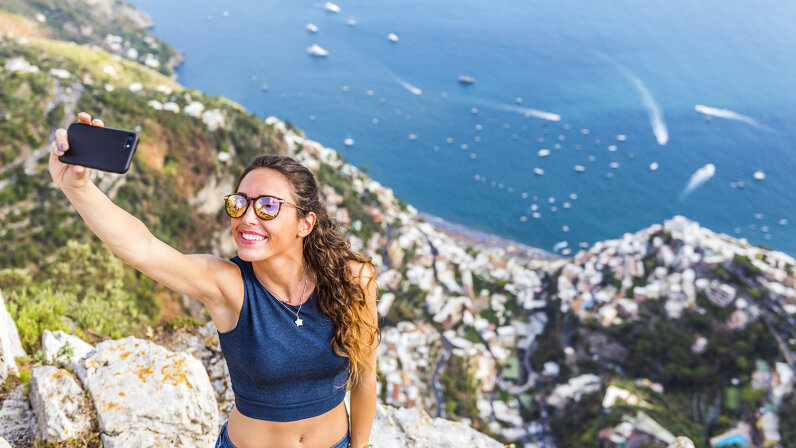 |
| Men and women across the globe are taking extreme risks to get the perfect selfie — and paying the ultimate price with their life. |
People Are Dying for the Perfect
Selfie
BY MICHELLE KONSTANTINOVSKY
Witnesses in Panama City, Panama, were horrified
on Friday, Oct. 12, 2018, when 44-year-old Sandra Manuela Da Costa Macedo plunged to her death from the 27th floor of
the Luxor Tower after she was spotted — and videoed — by nearby construction
workers while taking selfies from her balcony railing.
The construction workers, who were concerned for
Da Costa Macedo's safety, were shouting at her to get down just seconds before
she fell.
Unfortunately, stories like Da Costa Macedo's
are becoming more common.
According to a new study from researchers associated with
the All India Institute of Medical Sciences, at least 259 people have made the
ultimate sacrifice for the perfect photo.
That's how many selfie-related deaths occurred
between October 2011 and November 2017, anyway.
The study, published in the July/August 2018
edition of the Journal of Family Medicine and Primary Care, analyzed news
reports of the deaths, which lead author Agam Bansal called "a major
public health problem" in a Washington Post article.
The findings were illuminating, and more than a
little disturbing: The leading cause of selfie death was drowning, followed by
transportation-related accidents (like posing in front of an oncoming train)
and falling.
The mean age of victims was 22.94 years old.
"What worries me the most
is that it is a preventable cause of death," Bansal told the Washington Post.
"... Just because you
want a perfect selfie because you want a lot of likes, shares on Facebook,
Twitter or other social media, I don't think this is worth compromising a life
for such a thing."
While American selfie deaths have been widely
reported in the States, India ranks as the country with the highest number
(150), followed by Russia (16), the U.S. (14) and Pakistan (11).
According to the analysis, most of the deaths
were males — about 72.5 percent — the remaining were females.
And while "risky behavior" caused more
deaths and incidents than "non-risky behavior," females were less
likely to die due to risky behavior than non-risky behavior.
However, male deaths were almost three times
more likely to be because of risky circumstances.
Researchers considered incidents "risky
behavior" when it was "quite evident that the person took risk to
click a selfie and lost her life."
Scaling a slippery cliff edge to snap a selfie,
for example, would be considered risky, while getting hit by an unexpected wave
in calm waters would not.
Though the study only analyzed news reports up
to November 2017, the number of selfie deaths doesn't appear to be dwindling.
Several stories have been widely reported,
including one of a man in India who was mauled to death after trying to snap a selfie with an injured bear, and
another of an 18-year-old hiker who fell more than 800 feet (243 meters) from a
Yosemite National Park cliff.
While the news remains grim, the researchers
have a recommendation they believe could help prevent future deaths: "'No
selfie zones'" areas should be declared across tourist areas especially
places such as water bodies, mountain peaks and over tall buildings to decrease
the incidence of selfie-related deaths," the study concluded.
That concept is already catching on in some
places: Russia launched a "Safe Selfie" campaign three years ago,
and Mumbai declared 16 "no selfie zones" in 2016.
The best way to stay safe? Practice common sense
and remember no amount of likes is worth tragic consequences.
So the moral of the story is to save your selfies for celeb encounters and avoid
documenting scary scenarios — and maybe consider skipping the risky stuff
altogether and just pass the time trying out weird face filters at home
instead.
NOW THAT'S SERIOUS
According to some mental health professionals,
selfie addiction is a real mental illness.
One study suggests that chronic
selfie-takers "have an uncontrollable urge to point their phone at
their face and post the selfies on social media more than six times per
day."
Michelle
Konstantinovsky is a San
Francisco-based journalist who's written on everything from the Beagle Brigade
and border walls to cricket farms and TV scheduling for HowStuffWorks. She
earned her master's degree from U.C. Berkeley's Graduate School of Journalism
and she's written on health and wellness topics for outlets including
Cosmopolitan, O: The Oprah Magazine, Marie Claire, Teen Vogue and more.
Michelle loves music, manatees and terrible teen movies from the early 2000s.


No comments:
Post a Comment